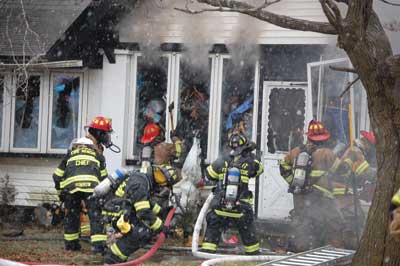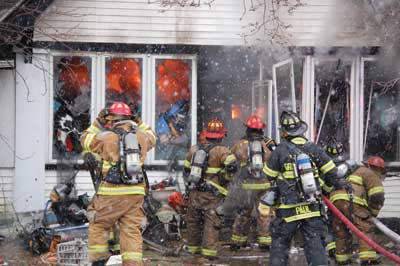BY BILL GUSTIN
Hoarding, also known as “pack rat” conditions, changed what should have been a routine room-and-contents fire in a small private dwelling into a long and difficult operation. This homeowner had, over several years, accumulated clothing, furniture, newspapers, and other items to the point that the house was filled from wall to wall and floor to ceiling. This fueled a nasty, smoldering fire, producing heavy, dense smoke that eventually flared up into open flame when firefighters created openings to ventilate and gain access.
From the exterior, this appears to be a house that is well maintained and is in a nice suburban neighborhood. Photo 1 teaches a valuable lesson: Hoarding is not exclusive to any economic or social class; a fire involving hoarding can occur in any community. A hoarder fire is far from just a fire problem and, therefore, cannot be handled entirely by the fire department. Hoarding can become a public health and sanitation problem, a code enforcement problem, and a social and mental health problem. Although hoarders are most often elderly, hoarding is a result of mental illness that can afflict adults of any age. In terms of private property rights, a man’s home is, in the eyes of the law, legally his “castle,” and a homeowner is fairly free to fill his castle with as much stuff as he can fit in it. Consequently, firefighters may find hoarding conditions in a private residence while on a medical call and may be powerless to do anything about it. In most cases, it isn’t until hoarding becomes a menace to the public that government can get involved.

PREPLAN WITH OTHER AGENCIES
Do not wait for a hoarder-associated fire to develop a plan of action. Develop a plan in advance to ensure that all agencies involved are capable of providing the assistance and resources necessary. Consult with your city attorney or legal department to clarify conditions when a person’s right to hoard infringes on his neighbor’s right to not live next to a health and fire hazard. Similarly, involve the building department or code enforcement department; usually those agencies can condemn a hoarder home or post an “unfit for human habitation” notice on the front door.
A fire department fighting a hoarder fire will rely very heavily on the Public Works and Sanitation departments because it can be almost impossible to fully extinguish stacks and piles of smoldering contents without removing them from the fire building. Heavy equipment such a backhoes and front-end loaders from the Public Works Department will save firefighters hours of miserable, backbreaking work carrying water-soaked smoldering contents outside. When planning for a hoarding fire, work with the Sanitation Department to make every effort to dispose of contents removed from the fire building as soon as they are completely extinguished. Leaving a fire scene with a huge pile of debris in the front yard of a hoarder’s home is not in the best interest of neighborhood residents, especially next-door neighbors.
Hoarding becomes a public health problem when cockroaches and rats infest stacks and piles of contents and scurry out of their nests when disturbed by smoke or firefighters. Vermin, forced out of a fire building, will look for another home and are likely to take up residence in nearby homes. It is, therefore, critical to seek participation from public health officials when developing a plan to handle fires involving hoarding conditions.
Social service agencies must also have input in a plan because hoarders are often mentally or physically unable to take care of themselves and are terrified of leaving their homes. When hoarders must be relocated, mental health professionals and social service agencies must be involved to ensure that the hoarders are treated with compassion and dignity.
Finally, no community’s plan for handling hoarder fires is complete without the involvement of animal protection-control agencies because hoarders may hoard a large number of animals as well.
HOSELINE OPERATIONS
In photos 1 and 2, firefighters encounter burning contents stacked to the ceiling and begin to open the structure to ventilate and access the fire. Notice that the screen door opens outward, indicating that the front door opens inward. Contents blocking the inward swing of the front door make it impossible or dangerous to gain entry by this route. Consider that a firefighter in full protective clothing and self-contained breathing apparatus weighing 300 pounds may be able to use his body weight to push open the door wide enough to enter. The danger in this route of entry is when it must become a route of exit because the firefighter’s upper body strength may not be sufficient to pull the door open. When an inward-swinging door is blocked by contents or unconscious people, consider forcing it at its hinges.
In photo 1, water spraying from a hole in the hoseline reduces the flow to the nozzle. Fire hose manufacturers are constantly trying to find the ideal balance of durability and maneuverability. It is possible to manufacture hose that is almost puncture- and melt-resistant, but the hose would be too stiff and heavy to easily move up stairs and around corners.
Veteran firefighters remember when fire hose had two woven cotton outer jackets, a natural rubber lining, and heavy brass couplings. Old hose was inherently resistant to puncture from contact with sharp objects or hot surfaces. It was, however, heavy and stiff compared with today’s hose and required drying after use to prevent mildew of the cotton jackets and a corrosive chemical reaction of water and the rubber lining. Today’s fire hose, made of synthetic materials, is lighter and more maneuverable than older hose, and it can be packed wet but is vulnerable to puncture and melt-through.
Since you can never fully prevent holes in hose that reduce flow on a fire, consider such a possibility when determining the intended or “target” gallon-per-minute (gpm) flow for interior fire operations. Say, for example, that a department decides that 125 gpm is sufficient for a room-and-contents fire in a compartmented residential occupancy. This flow may be dangerously inadequate for today’s residential room-and-contents fire because the typical American house is filled with contents made of petrochemical-based synthetic materials that burn with a very rapid heat release rate. These fires can exceed the suppression capability of a hoseline flowing 125 gpm.
Additionally, modern homes lack the compartmentation that was common with conventional home design. Vaulted ceilings and open floor plans in modern homes can allow a fire to grow to a volume that can overwhelm a hose flowing 125 gpm. As the heat release rate and volume of residential fires have increased, many fire departments have increased the flow capability of their 1¾-inch and two-inch hoselines for interior residential fire attack; flows of 150 to more than 200 gpm are not uncommon.
Another justification for increasing the flow rates of hoselines for residential fires is that they provide a greater margin of safety. Consider the reduction in flow if a hoseline flowing 125 gpm becomes kinked or punctured; this diminished flow can put a nozzle team in jeopardy.

Notice the absence of flame in photos 1 and 2. This is indicative of a ventilation-controlled/-limited fire that is starving for oxygen. Breaking the windows for ventilation and access also provides an inlet to supply the fire with oxygen. Notice also that the fire does not immediately flash into flame the moment the windows are broken. This fire behavior is consistent with research on ventilation-limited fires conducted by the National Institute of Standards and Technology and Underwriters Laboratories. Researchers have documented that it can take several seconds for oxygen and unburned fuel gases to mix in the proper proportion to transition to flaming combustion. As firefighters make ventilation openings, they anticipate an intensification of this fire as it finds additional oxygen and are ready with charged hoselines in position.
In photo 3, the fire intensifies with the additional supply of oxygen. Firefighters are faced with a difficult task. Options for handling a deep-seated fire like this include applying Class A foam or a wetting agent to enhance the penetration of water, bombarding it with high-velocity master streams equipped with smooth bore nozzles for penetration, and using heavy equipment to move smoldering material outside where it can be pulled apart and saturated with water. The third option, using heavy equipment, may be the only solution if you cannot completely extinguish the burning contents inside the house. Experienced firefighters know that they can flood a large, deep-seated fire with tons of water and it can continue to smolder for days. Notice the nozzle on the hoseline being held by Firefighter Paul; it is equipped with a ½-inch “overhaul tip.” If firefighters choose to remove smoldering contents, this nozzle tip is an excellent choice because of the penetration of its high-pressure/low-volume stream.

One of the most unpleasant aspects of hoarder fires is contending with cockroaches that flee from their nests deep inside piles of contents and find their way into pockets and between layers of firefighters’ protective clothing. Roaches are notorious for crawling up the legs of bunker pants and hiding between the outer shell and thermal lining. Firefighters can reduce the chances of “stowaways” getting back to the firehouse by wrapping duct tape around the cuffs of their coats and bunker pants and thoroughly examining their protective clothing before returning to quarters.
● BILL GUSTIN is a 40-year veteran of the fire service and a captain with the Miami-Dade (FL) Fire Rescue Department. He began his fire service career in the Chicago area and conducts firefighting training programs in the United States, Canada, and the Caribbean. He is a lead instructor in his department’s officer training program, is a marine firefighting instructor, and has conducted forcible entry training for local and federal law enforcement agencies. He is an editorial advisory board member of Fire Engineering and an advisory board member for FDIC. He was a keynote speaker for FDIC 2011.
More Fire Engineering Issue Articles
Fire Engineering Archives

